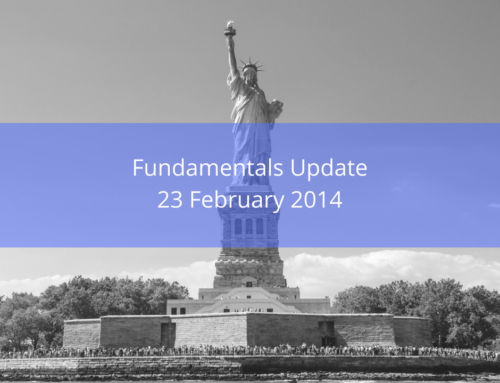EU Banking Union
Fundamentals Update as at 17 March 2014 by Lorenzo Beriozza
It is a common understanding that a banking union – and a proper fiscal union, too – is essential for the long-term viability of the euro construct. However, it is also true that the urgency for a banking union has faded, in particular with the re-opening of financial markets in most peripheral euro area countries. Markets do not appear to need a banking union right now.
The banking union is proceeding, though – with hiccups and some delays. The situation is very different from what it was before Draghi’s “whatever it takes” pronouncement. The OMT, current account surpluses in all peripheral countries, and improving economic prospects have made the banking union somewhat redundant as an immediate crisis resolution tool. Banks in the periphery are able to access market funding and financial stress is lower than it has been in a while.
The, potentially real, risk that the European parliament won’t agree on the key second block of the Banking union, the Single Resolution Mechanism, before the May European elections is not perceived as a fundamental risk for the euro area anymore, probably because the expectation is that the banking union will happen anyway now, even if later than expected. Progress appears real.
Below are some findings on the banking union progress from recent meetings in Brussels, mindful that, even if not a key market driver at the moment, its importance can be reaffirmed if the crisis resurfaces.
There are indications about the current state of affairs on three key developments related to the banking union. Namely:
- The progress on the Single Resolution Mechanism (SRM), the second building block of the Banking Union – the first block, the Single Supervisory Mechanism (SSM), was finalised last November;
- The progress on the direct bank recapitalisation tool, which was seen last year as the best way to break the sovereign/ banks link;
- The impact of the banking union-related Asset Quality Review (AQR) on the lending behaviour of banks.
While an agreement has not been finalised yet by the euro area finance ministers (Ecofin), ministers sounded conciliatory with the concerns raised by the European Parliament (EP) at last month’s meeting.
The EP is particularly concerned with three issues:
- The decision process to decide on a bank resolution is too cumbersome and involves too many (national) players;
- The period over which the Single Resolution Fund (SRF) becomes truly European (i.e. there is proper mutualisation) is too long;
- Part of the deal reached by the finance ministers is based on an intergovernmental agreement, so outside of European law and outside the control of the EP, which is seen as unacceptable by the European Parliament (although it must be acknowledged that most European agreements started as an intergovernmental deal, including, for example, the ESM).
Background on the SRM is as follows. In December, the Council agreed on a general approach involving both a regulation on the SRM and a commitment to negotiate an intergovernmental agreement on the functioning of the Single Resolution Fund (SRF), the funding arm of the SRM. The intergovernmental agreement includes arrangements for the transfer of national contributions (financed by bank levies) to the SRF and their progressive mutualisation over a 10-year transitional phase. The fund would initially consist of national compartments that would be gradually merged over the 10-year transition period, with mutualisation between national compartments progressively increasing. So while during the first year any costs outstanding for resolving banks, after use of bail-in provisions, would mainly come from the compartments of the member states where the banks are located, the share would gradually decrease as the contribution from other countries’ compartments increases. The SRM should enter into force on 1 January 2015.
The indication received from officials in Brussels is that the reduction of the transition phase for full mutualisation of the SRF, from ten to seven or eight years, is actively considered. It was also noted, though, that under current rules, already from, say, year four, a large recapitalisation requirement from a small country would be easily covered, given the progressive mutualisation and the relatively important size of the fund for the smaller euro area countries (e.g. Portugal, Greece or Ireland). Streamlining the governance of the SRB, and reducing discretionary powers, was also seen as a likely change to the Council proposal, in line with requests from the EP. On the probability of reaching an agreement before the European elections (in May), officials saw it higher than 50%, but by no means a certainty, with the key date for such approval being the European Parliament plenary session of late April 2014. That being said, no one expressed the view that a failure of the EP to vote on the SRM would mean that the project would be abandoned. All expected an agreement with the new Parliament in the summer, at the latest. In a sense, the imposed schedule is very tight and a delay might produce a better deal, even if somewhat later than desired. Overall, it is unlikely that a delay might be perceived as highly disruptive by markets.
Direct bank recapitalisation via the ESM, was seen, at the height of the crisis, as the single instrument capable of breaking the sovereign/ banks link and to stop financial contagion. The practical definition of the instrument is proceeding slowly expectations are now that a final agreement will be, finally, reached next week. But it has lost its urgency. To be fair, this tool is not expected to be used today or in the future, unless a major new crisis unfolds. A much better way to deal with a banking crisis would be to add a tool to the ESM toolbox, i.e. the ability to lend to the SRF. That said, direct recapitalisation will be an available tool by the end of this year, right after the AQR results, and it is worth up to €60 billion of ESM money, which is a non-negligible amount. As such, it is a further safety net of last resort in case of a recrudescence of the financial crisis. The risk of continued credit restriction this year is seen as material, even though the ECB will base its assessment on the balance sheets of the banks at the end of 2013. It was pointed out that banks would likely not want to go on a lending spree and remain conservative just before the AQR results, and as such 2014 would be likely still a difficult year for credit. Data available are mixed, with M3 data showing some impact from the AQR (although the dreadful December 2013 figures were partly corrected in January) and with slightly more less negative indications coming from the ECB bank lending survey, as the charts below illustrate. These are the indicators to monitor over the next few months.
Source: Credit Suisse


